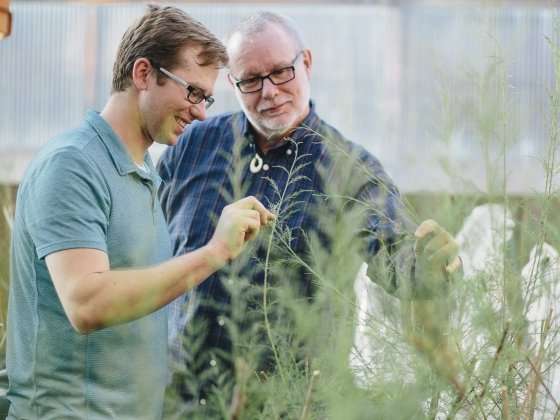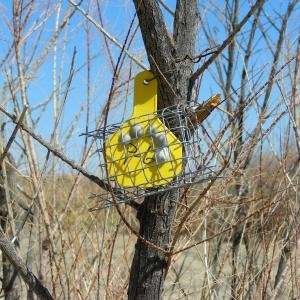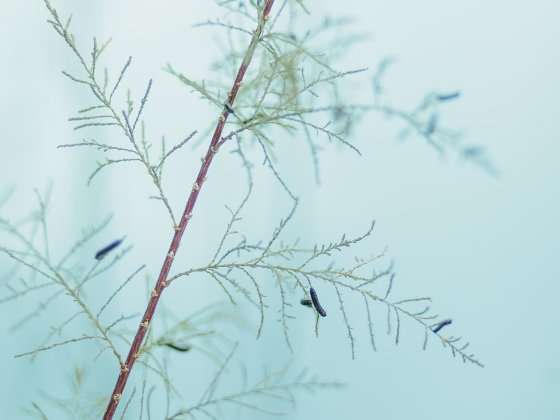Researchers find that beetle odor could help tackle tamarisk

In the fight against an invasive plant colonizing portions of the state, a Montana State University doctoral student is luring shrub-munching beetles with an odor as tantalizing to them as the smell of bacon and pancakes, or perhaps a barbecue, is to humans.
"It communicates that it's a safe area, that there's lots of food," researcher Alex Gaffke said of the scent, which is a synthetic version of a pheromone that northern tamarisk beetles release to alert others to feeding areas.
"The beetles are very eager, very gregarious," Gaffke said. "They all want to be where the party is."
According to Gaffke, scientists have known about the beetle pheromone for a decade or more. But for the first time, his research team has demonstrated the potential for using the odor as a tool for combating the spread of tamarisk—the non-native shrub that the beetles feed on.
By attaching small dollops of a waxy, putty-like substance containing the pheromone, the researchers found that they could more than double the number of tamarisk beetles congregating on the bushes, which often doubled the die-back of the plants as the beetles consumed the leaves and twigs.
"We did not expect to see this level of impact," Gaffke said. "We really had no idea whether it would work or not."
The researchers published the results of their multi-year study, which took place along the Bighorn River in Wyoming, in the journal Pest Management Science in January.

"This paper is something pretty special, because it really shows a proof of the concept," said David Weaver, a member of the research team and a professor in the Department of Land Resources and Environmental Sciences in MSU's College of Agriculture.
Weaver said the research has already generated "great interest" among land managers tasked with controlling tamarisk, which has gained a foothold along waterways in eastern Montana. The invasive shrub—also called saltcedar—crowds out cottonwoods and other native vegetation, consumes inordinate amounts of water and forms thickets so dense they contribute to flooding.
Starting in 1999, the U.S. Department of Agriculture released northern tamarisk beetles from Kazakhstan and China as a form of biocontrol at the Wyoming study site and across the western U.S. But in areas of Wyoming and Montana, where tamarisk is spread more thinly on the landscape, the beetles—which eat only tamarisk—struggled to reproduce and achieve a density that could have a significant impact on tamarisk, according to study co-author Sharlene Sing, a research entomologist at the Rocky Mountain Research Station in Bozeman, which is operated by the USDA's Forest Service.
That makes the results of the study particularly important for Montana, said Sing, who earned her doctorate in land resources and environmental sciences from MSU. The findings suggest that the pheromone could be used to concentrate migrating beetles in areas that are priorities for tamarisk control. By congregating in greater densities, the beetles are also more likely to reproduce and grow their numbers, she said.
Compared to other methods of battling tamarisk, which include herbicides and mechanical removal, the synthetic pheromone would be a more precise, lower-cost method to use in areas where tamarisk is starting to colonize but hasn't yet dominated, such as along the Yellowstone River near Billings, Sing said.

Gaffke, a Bozeman-area native who earned his bachelor's in environmental biology from MSU before starting his doctoral research with Weaver, is working on another paper that will make practical recommendations to land managers about how to use the beetle odor.
"I like working on taking science … and developing tools to apply it in the field," he said.
More information: Alexander M Gaffke et al, Semiochemicals to enhance herbivory by Diorhabda carinulata aggregations in saltcedar (Tamarix spp.) infestations, Pest Management Science (2018). DOI: 10.1002/ps.4848
Journal information: Pest Management Science
Provided by Montana State University



















